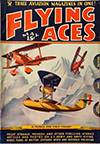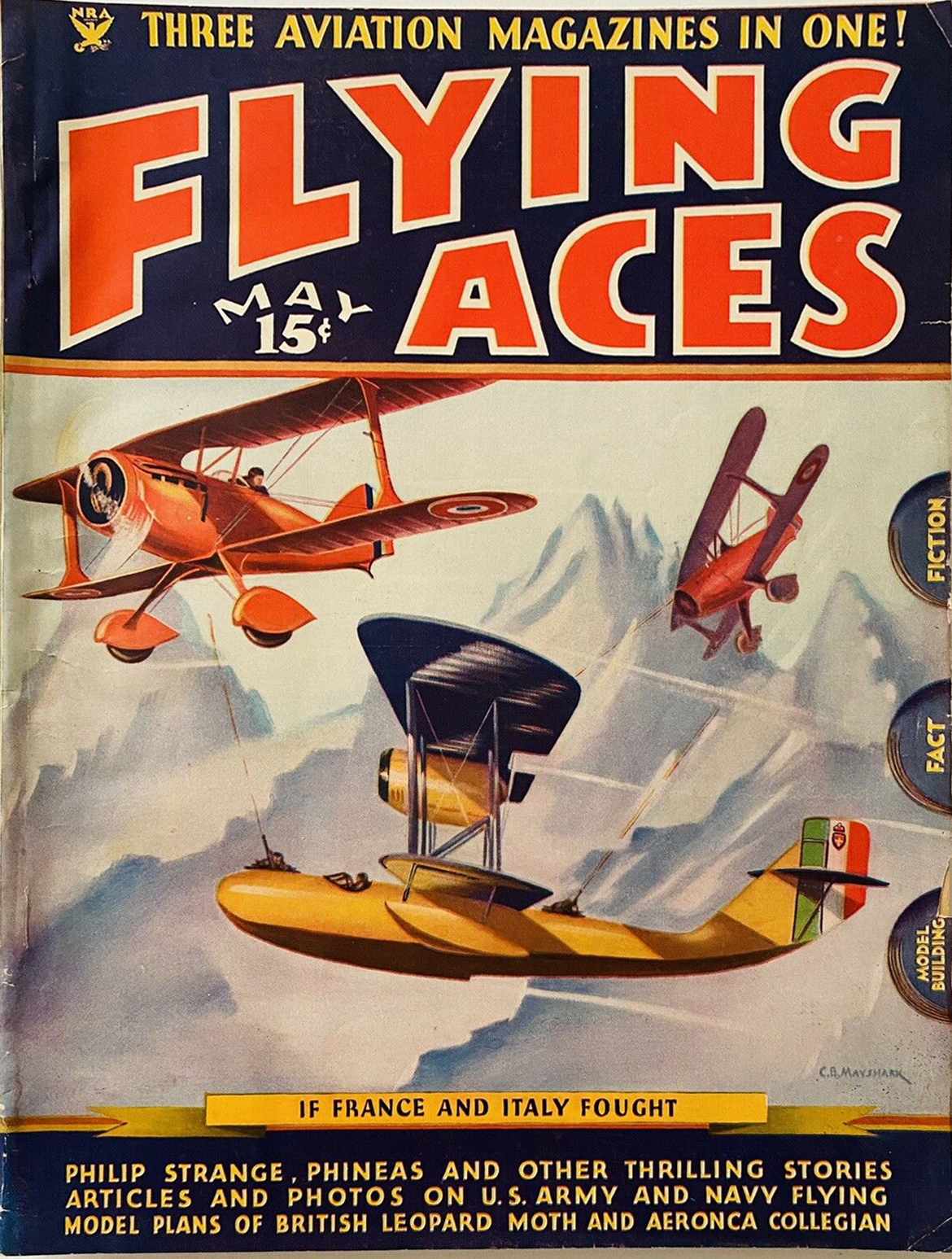“Flying Aces, May 1935″ by C.B. Mayshark
THIS May we are once again celebrating the genius that is C.B. Mayshark! Mayshark took over the covers duties on Flying Aces from Paul Bissell with the December 1934 issue and would continue to provide covers for the next year and a half until the June 1936 issue. While Bissell’s covers were frequently depictions of great moments in combat aviation from the Great War, Mayshark’s covers were often depictions of future aviation battles and planes, like May 1935’s thrilling story behind its cover which imagines what an aerial fight between France and Italy might look like!
If France and Italy Fought
 DEATH in the Alps! Smashing tracer that severs control wires and snuffs out human lives with equal ease! Pursuit ships tearing across frigid skies with reckless abandon, primed for the kill! A powerful reconnaissance flying-boat winging its way belligerently towards a French objective! All this and more could happen on the mountainous Franco-Italian border.
DEATH in the Alps! Smashing tracer that severs control wires and snuffs out human lives with equal ease! Pursuit ships tearing across frigid skies with reckless abandon, primed for the kill! A powerful reconnaissance flying-boat winging its way belligerently towards a French objective! All this and more could happen on the mountainous Franco-Italian border.
Let us suppose that an Italian flying-boat is ordered to fly over French territory on a secret reconnaissance job. The resultant information is to be used by a fleet of bombers which are to wipe out certain industrial centers in the south of France. Munition manufacturing plants are to be the prime objective, most of which are within easy range of Italian flying fields. But everything depends upon the success of the reconnaissance expedition.
The Cant flying-boat has almost reached the border when two French single-seaters tear into view. Something has leaked out! The French are aware of the impending danger, and they are determined to avert disaster. But the three Italian airmen must carry out their orders, and they prepare for the imminent encounter.
Flying a ship in the Alps Mountains is at best no simple task. There are towering snow-capped peaks which mask themselves in the surrounding hazy atmosphere, and they are a constant menace. Treacherous air currents are also particularly dangerous, so that a pilot never knows when his ship is going to be sucked down and smashed. Then, too, the wind reaches such a high velocity at times that it is almost impossible to turn the controls against it.
Having learned of all these dangers through painful experience, the French and Italian airmen proceed warily. Circling at a safe altitude above the Italian ship, the French fighters wait for a chance to strike. But the Italians do not deviate from their course. They, too, are waiting.
Suddenly, without warning, one of the Frenchmen drops. Like a plummet he falls, seemingly out of control. But quickly, as if he had hit something solid, he pulls out of the dive. Now the Italians are directly in the Frenchman’s line of flight, and as the pilot of the fighter turns on the heat, two murderous streams of machine-gun tracer splatter upon the wings of the flying-boat.
Now the Frenchman is forced to pull up and retreat to safety. The rear gunner in the Italian ship has entered into the picture and is returning the fire with a zest. In the meantime, the second Frenchman has projected himself into the fray. The Hisso motor screams as the single-seater lunges down, but again the Italians are successful in beating off the speedy enemy.
And so back and forth across the sky weave the three planes, the French ships possessing the greater speed, and the Italians the greater fighting power.
It is difficult to predict the outcome of such an air battle. Although the flying-boat does not possess great speed or maneuverability, its two gunnery should be able to protect it against any reasonable attack. On the other hand, the speed and the fighting fury displayed by the French single-seaters give rise to the belief that nothing could withstand the power of their vicious onslaught.
The Italian ship taking part in this air battle is a Cant 21 bis two-seater reconnaissance flying-boat. It is powered with a 500-horsepower Isotto Fraschini “Asso†engine. Gunners’ cockpits are situated in the rear and in the nose of the fuselage, the one in the nose being directly connected with the pilot’s cockpit. The ship’s speed is 134 miles per hour, and its range is ten hours.
The two French ships are Bleriot-Spad 510’s. This ship is designated as a single-seater high-altitude fighter. Its speed is 231 miles per hour, which places it among the fastest military planes in the world. Its power plant consists of one 500-horsepower Hispano-Suiza twelve-cylinder supercharged engine.
In view of the present fictitious description, it would be interesting to note the difference in the make-up of the French and Italian air forces. The Italians have a particularly difficult problem to face because of their geographical surroundings. Bounded on the south, east, and west by water as they are, the need for flying-boats and seaplanes can be readily seen.
On the other hand, an entirely different kind of aircraft is needed for work in the mountainous regions which bound the peninsula on the north. Italy leans more towards large, long-range ships than it does toward fast intercepter fighters. Very strenuous training must be undergone by all Italian military pilots, and once they have accomplished their training, their duties are varied and often hazardous. As a result, Italian military airmen rank among the best in the world. Proof of this fact was exhibited when General Balbo led the Italian Air Armada to America and back again to Italy in 1933.
When we look at the air arm of France, we see an entirely different picture. France has always been regarded as the nation which possesses greater strength than any other nation, in so far as fast pursuit jobs are concerned. Ever since the war, France has concentrated upon efficiency and speed in single-seater fighters. A great many different makes of pursuit and intercepter fighters are now in the French service, and their performance is indeed enviable. An example of this fact is to be found in the performance figures for the Bleriot-Spad. However, France is not lacking in reconnaissance and bomber types. Farman has been world-famous since the days of the war for the production of high-efficiency bombers.
The idea of anyone’s entertaining seriously the thought that the air battle pictured on our cover could actually take place is, in the light of present-day diplomatic developments, quite inconceivable. Our only aim has been to show our readers how representative ships of France and Italy would appear and what would be the advantages of each, if they were to engage in combat.

Flying Aces, May 1935 by C.B. Mayshark
If France and Italy Fought: Thrilling Story Behind This Month’s Cover






